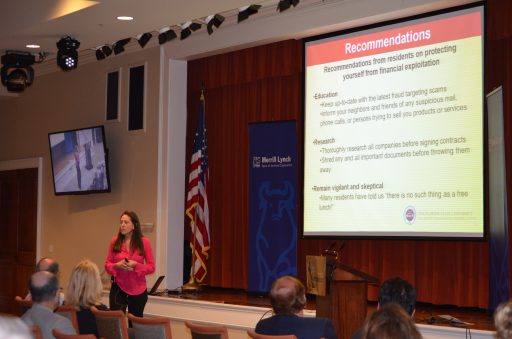
Around the holidays people tend to be in the giving spirit, but there are also scammers well aware of such generosity. The U.S. Consumer Financial Protection Bureau reports that although fraud targeting seniors happens every day, scammers often increase their efforts during the holiday season.
Enter Florida State University’s College of Criminology and Criminal Justice. Researchers, including Dean Thomas Blomberg, doctoral student Julie Mestre Brancale and George Pesta, director of the Center for Criminology and Public Policy Research, recently completed a full report on elder fraud and how to combat it.
“We needed to have better firsthand knowledge of how extensive the problem of elder financial fraud is in order to develop needed policies and practices that can effectively reduce this growing problem,” Blomberg said.
In 2011, the MetLife Market Institute reported that $2.9 billion was exploited from elderly victims — a 12 percent increase from 2008. The fastest growing segment of the U.S. population is 65 and older, so the occurrence and impact of elder financial fraud will likely continue to escalate.
Despite these alarming trends, there was little research on the facts, prevention and policies related to elder financial fraud. This lack of information led the College, in partnership with Merrill Lynch and Seniors vs. Crime, to begin a study on elder financial fraud in The Villages, one of the largest retirement communities in the nation.
The team addressed four questions through their research: One, what are the most common types of financial fraud perpetrated against the elderly? Two, what role do salient life events, such as retirement, death of a spouse and declining health have on the risk of elder financial fraud? Three, what are protective factors against elder financial exploitation? Four, what are the consequences of elder fraud victimization?
Combing through diverse data — including reported incident data, arrest statistics, national surveys, focus groups and interviews — researchers found that in The Villages between January 2010 and May 2015, there were 3,735 complaints of elder fraud victimization, but only 265 arrests. The average age of fraud victims was 72, and the average lost among the victims was $2,000 per claim. They also found the most common source of fraud was in home services, particularly unnecessary repairs.
The researchers also examined other types of fraud The Villages residents were exposed to, including misleading sales and advertisements, investment fraud, embezzlement, sweepstakes scams, fraud by health professionals, identity theft and forgery crimes. The report also addresses the methods used to exploit elderly victims and what made them particularly vulnerable to each type of fraud.

Salient life events, or “turning points,” such as death or incapacitation of a spouse, a significant health diagnosis, moving and changing social support networks proved to be the most common precursors for financial exploitation. As a result of victimization, residents of The Villages suffered psychological and emotional distress, impact on their quality of life and health, and devastating consequences for their financial security.
“I was surprised at how prevalent this problem is and how deeply affected residents were,” Mestre Brancale said. “No matter if they lost $50 or they lost $100,000, this victimization changed their lives and they were drastically impacted.”
Researchers also discovered that retirement communities provided a false sense of security to residents, raising the likelihood of exploitation among residents. Further, they determined that elder fraud is significantly underreported because victims are embarrassed and/or unaware how to report victimization.
In the report, Blomberg, Mestre Brancale, and Pesta give recommendations to help reduce vulnerability when it comes to elder fraud. They note that protective factors, such as education, skepticism and strong support networks help to reduce incidents of fraud.
The researchers also recommended that community service centers providing comprehensive services at a single location for seniors could help reduce elderly victimization. Effective services within the community service centers would be hotlines, list of “endorsed” services, classroom education, media outreach, “shopping buddy” programs, support groups and referral services.
Accordingly, community service centers that provide such services can act as a surrogate family or trusted friend, educating seniors to avoid exploitation and guiding them through the recovery process. The research team anticipates the recommendations, if applied and fostered, will reduce the prevalence of financial fraud.
“This is just another example of how the college is working to bring research to life,” Blomberg said. “Here, the college’s research provides real insight into problems confronting some of Florida’s most vulnerable citizens, the elderly, as well as recommendations for the prevention of elder financial exploitation.”
Researchers said there is more they hope to learn in order to help combat the crime.
“We really want to go out to other retirement communities and see if what we found in The Villages, we find in other retirement communities,” Pesta said. “We ultimately want to pursue an institute for the study of elder fraud and abuse at Florida State University in the College of Criminology and Criminal Justice.”
Read the full report, “Elder Financial Exploitation in a Large Retirement Community,” here.




